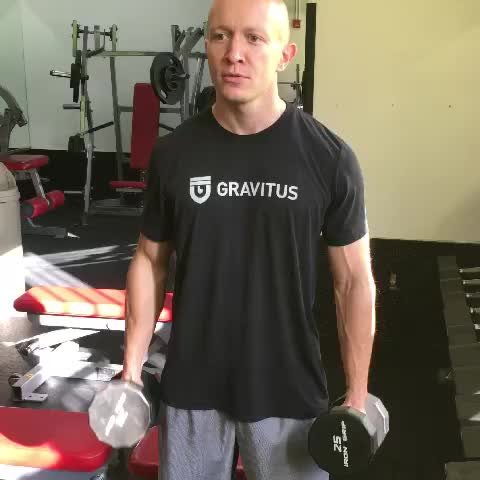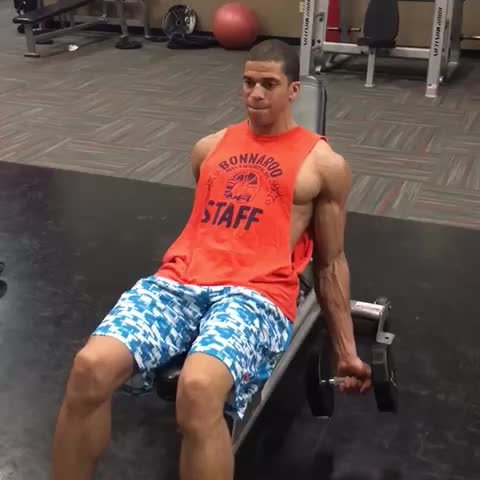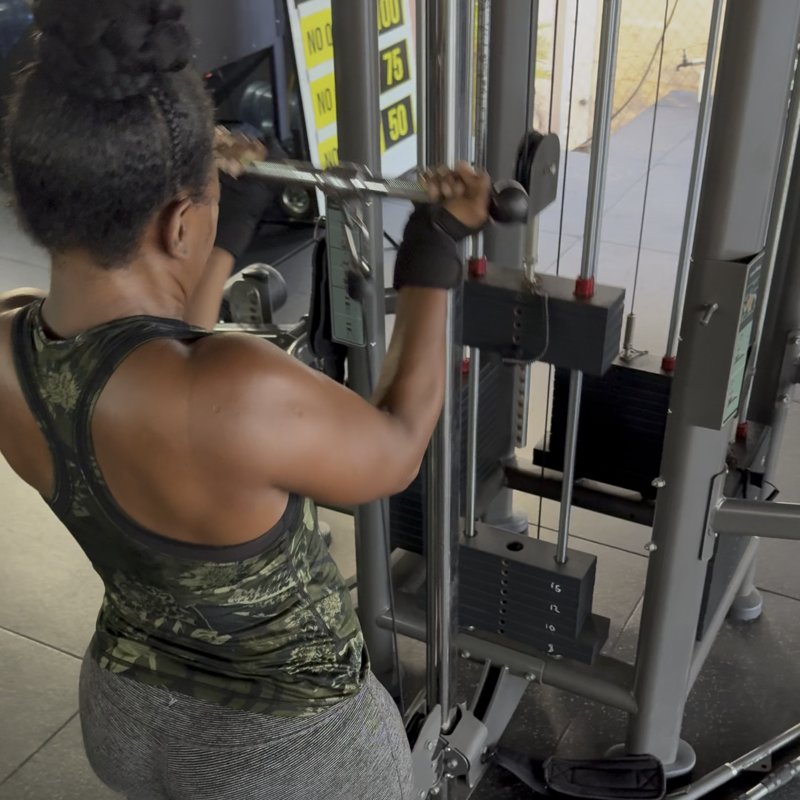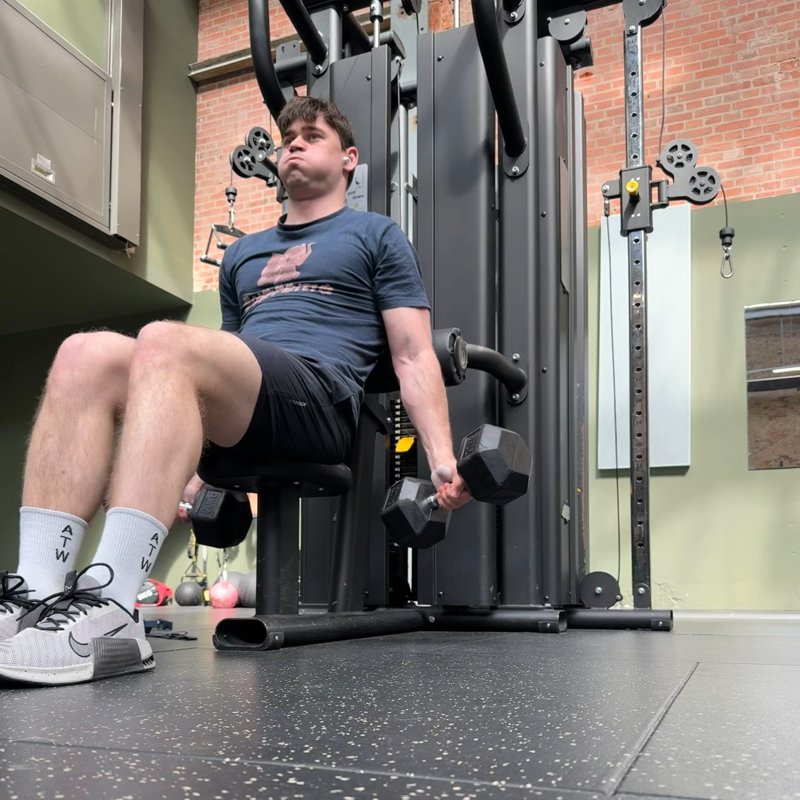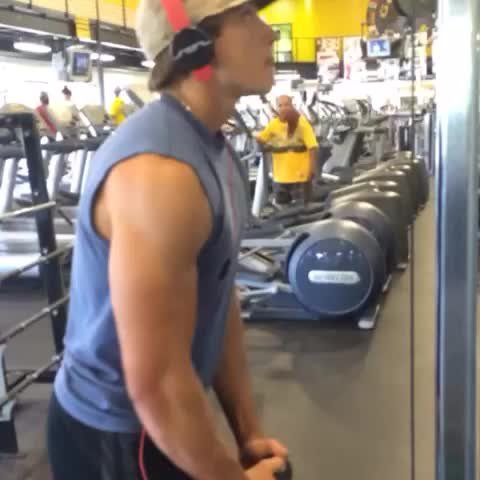Bicep Curl Machine: The Ultimate Guide
The Bicep Curl Machine is an isolation exercise performed on a specialized machine that guides arm movement through a fixed path, primarily targeting the biceps brachii muscles through controlled elbow flexion.
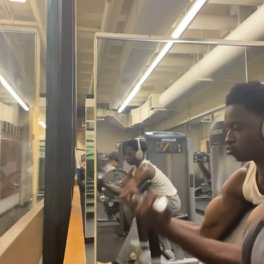
Quick Facts
Key Benefit
Targeted biceps isolation with controlled resistance
Primary Muscles
Biceps, Brachialis
Secondary Muscles
Abdominals, Anterior Deltoids, Forearms
Equipment
machine
Difficulty
Beginner
Type
Strength
In This Guide
Ready to master the Bicep Curl Machine?
Track your progress, see improvements over time, and build strength consistently.
Download GravitusThe Bicep Curl Machine provides a highly controlled environment for isolated biceps training, offering unique advantages that complement free weight exercises in a comprehensive arm development program. This specialized piece of equipment guides your movement through a fixed path, allowing for focused muscle activation with reduced demands on supporting musculature and stabilization. What makes the machine variation particularly valuable is its accessibility for beginners and those with specific training limitations. The guided movement pattern reduces the technical demands and stabilization requirements present in free weight curls, enabling greater focus on the target muscles without compromise. Additionally, the machine's design typically creates a unique resistance profile throughout the range of motion—sometimes providing accommodating resistance via a cam system that matches the biceps' natural strength curve. This can increase tension at points where the muscle would normally experience reduced load in traditional free weight movements. While not a replacement for free weight training, the Bicep Curl Machine offers valuable variety in resistance type, allowing for concentrated biceps work with precise control over form. Whether you're a beginner learning proper elbow flexion patterns, an intermediate lifter adding isolated volume to your program, or an advanced athlete seeking to overcome plateaus through targeted work, this machine provides an effective and joint-friendly addition to your arm training arsenal.
Benefits of Bicep Curl Machine
The Bicep Curl Machine offers several distinct advantages that make it a valuable addition to your arm training routine.
Isolated Targeting
Eliminates much of the body English and momentum that can diminish biceps engagement in free weight movements, ensuring direct stimulation of the target muscles.
Reduced Technical Demand
The guided motion simplifies the exercise, making it accessible for beginners and allowing more advanced lifters to focus solely on muscle activation rather than stabilization.
Joint-Friendly Option
Often places the wrists, elbows, and shoulders in mechanically advantageous positions, potentially reducing stress on these joints compared to some free weight variations.
Consistent Tension
Many machines feature cam systems that maintain relatively consistent tension on the biceps throughout the range of motion, potentially enhancing muscle fiber recruitment.
Progress Tracking
The systematic nature of machine training—with precise weight selection and fixed movement paths—makes tracking progressive overload straightforward and objective.
Proper Form & Technique
Setup
- Adjust the seat height so that when seated, your armpits align with the pivot point of the machine.
- For machines with an adjustable preacher pad, position it to support your upper arms comfortably.
- Set your elbow position on the pad or at the designated area of the machine.
- Grasp the handles with a comfortable, firm grip—typically with palms facing upward (supinated).
- Position your upper arms flat against any support pads, creating stability throughout the movement.
- Sit with proper posture—chest up, shoulders back, and core engaged.
- Keep your feet flat on the floor, approximately shoulder-width apart for stability.
- Adjust the weight selector pin to an appropriate resistance for your strength level.
Movement
- Begin with your arms extended but not completely locked out, maintaining slight tension in the biceps.
- Initiate the movement by flexing your elbows, curling the handles upward.
- Focus on contracting your biceps throughout the entire curling motion.
- Curl until your forearms make a 30-45 degree angle past perpendicular to the floor, or according to the machine's design limitations.
- Briefly squeeze your biceps at the top contracted position.
- Slowly lower the weight back to the starting position with control, maintaining tension throughout.
- Avoid letting the weight stack touch down between repetitions to maintain constant tension.
- Repeat for the desired number of repetitions, focusing on smooth, controlled movement.
Key Form Tips
Range of Motion
Use the fullest range of motion the machine allows without compromising form or causing discomfort.
Upper Arm Position
Keep your upper arms stationary throughout the movement - they should not lift or shift from their supported position.
Contraction Focus
Concentrate on the feeling of the biceps contracting rather than just moving the weight, enhancing the mind-muscle connection.
Controlled Negative
Resist the weight during the lowering (eccentric) phase rather than letting it drop, as this portion is crucial for muscle development.
Breathing Pattern
Exhale during the exertion phase (curling up) and inhale during the lowering phase to maintain proper oxygen flow and core stability.
Muscles Worked
Primary Muscles
- biceps: The two-headed muscle on the front of the upper arm, responsible for elbow flexion and forearm supination.
- brachialis: The muscle located underneath the biceps brachii that assists with elbow flexion regardless of forearm rotation.
Secondary Muscles
- brachioradialis: The forearm muscle that assists with elbow flexion, particularly in neutral grip positions.
- anterior deltoids: The front portion of the shoulder muscle that provides minor assistance during the curling motion.
- forearms: The muscles of the forearm that activate during gripping and assist with wrist stabilization throughout the movement.
- abdominals: Engage isometrically to maintain proper posture and stability during the exercise, though to a lesser degree than in free weight variations.
Common Mistakes and How to Fix Them
Using Excessive Weight
Selecting a weight that's too heavy, leading to compromised form and reduced biceps activation. Choose a weight that allows you to complete all repetitions with proper form while still challenging your muscles in the final few reps. Focus on feeling the biceps working throughout the entire range of motion rather than simply moving the weight from point A to point B. Consider temporarily reducing the weight to perfect your form and mind-muscle connection before progressing to heavier loads.
Incomplete Range of Motion
Not allowing adequate extension at the bottom or flexion at the top of the movement, limiting muscle development. Ensure you begin each repetition with your arms nearly extended (while maintaining slight tension) and curl to a fully contracted position. Avoid stopping the movement prematurely in either direction. If range of motion is limited by the machine's design, adjust your position if possible or consider supplementing with exercises that allow complete range.
Lifting Upper Arms
Allowing the upper arms to rise from the support pad, which introduces shoulder movement and reduces biceps isolation. Keep your upper arms firmly pressed against any support pads throughout the entire movement. Focus on moving only your forearms while your upper arms remain stationary. If this is difficult, consider temporarily reducing the weight until proper form becomes second nature.
Using Momentum
Utilizing body movement or jerking motions to assist with lifting the weight rather than relying on biceps strength. Maintain a controlled tempo for each repetition, with particular attention to the lowering phase. Consider implementing a specific tempo prescription (e.g., 2 seconds up, 1 second squeeze, 3 seconds down) to eliminate momentum completely. If maintaining control is difficult, the weight is likely too heavy.
Improper Seat Adjustment
Positioning the seat incorrectly, which can alter the intended movement pattern and reduce effectiveness. Take time to properly adjust the seat height so that the pivot point of the machine aligns with your shoulder joints or as the manufacturer recommends. Ensure that when seated, you can reach the handles comfortably while maintaining good posture. If you're between adjustment settings, opt for the position that feels most natural and allows the greatest biceps engagement.
Bicep Curl Machine Variations
Equipment Variations
-
Preacher Curl Machine
A variation where the arms rest on an angled pad, emphasizing the lower portion of the biceps and limiting the ability to use body momentum.
-
Cable Curl Station
Uses cables rather than a weight stack and cam system, providing constant tension throughout the range of motion.
-

Plate-Loaded Curl Machine
Allows for more incremental weight adjustments and often a slightly different resistance profile compared to pin-loaded machines.
-

Unilateral Curl Machine
Enables training each arm independently, addressing potential strength imbalances between sides.
Technical Variations
-

Supinated Grip Curl
The standard grip with palms facing upward, maximizing biceps brachii engagement, particularly the long (outer) head.
-
Neutral Grip Curl
Using a grip with palms facing each other (if the machine allows), increasing emphasis on the brachialis and brachioradialis.
-

Pronated Grip Curl
Performed with palms facing downward (if the machine design permits), placing greater emphasis on the brachialis and forearm muscles.
-

Partial Repetition Curl
Intentionally using a limited range of motion to maintain tension in a specific portion of the strength curve, often as an intensity technique.
Frequently Asked Questions
Machine and free weight bicep curls each offer distinct advantages rather than one being universally "better" than the other. Machine curls provide a fixed movement path that can enhance isolation of the target muscles by reducing the need for stabilization from supporting muscle groups. This guided motion often allows lifters to focus more intently on the mind-muscle connection with their biceps. The controlled nature of the machine can be particularly beneficial for beginners learning proper form, those rehabilitating from injury, or when fatigue has compromised stabilizer strength. Free weight curls (with dumbbells or barbells) engage more total muscle mass due to the increased stabilization requirements and typically provide greater functional carryover to real-world activities. They also allow for more natural movement patterns that conform to individual body mechanics. Additionally, free weights enable a wider variety of curl variations and angles that can target different aspects of the biceps. Rather than viewing them as competing alternatives, consider incorporating both machine and free weight curls in your training program. Many successful approaches use free weight exercises for primary biceps work when fresh, followed by machine-based movements for additional volume when stabilizers might be fatigued. This combination allows you to capitalize on the benefits of both training modalities for more comprehensive biceps development.
The appropriate weight depends on your experience level, current strength, and training goals. As a general guideline, select a weight that allows you to complete your target repetitions with proper form while still finding the last 2-3 reps challenging. For beginners, this typically means 12-15 repetitions with a weight that feels moderately difficult. Intermediate lifters might work in the 8-12 repetition range with a more challenging weight. Advanced lifters might occasionally use heavier weights for 6-8 repetitions to emphasize strength development. The key indicator is form - if you're unable to keep your upper arms stationary, maintain a controlled tempo, or achieve a full range of motion, the weight is too heavy. Biceps typically respond well to various rep ranges, but tend to develop optimally with moderate to higher repetitions (8-15) with perfect form rather than maximum loads with compromised technique. Progressive overload remains important, but for isolation exercises like this, progression can effectively come through increased time under tension, improved mind-muscle connection, and perfect form rather than simply adding weight. Many successful programs periodize training to include both heavier, lower-rep phases and lighter, higher-rep phases to stimulate different aspects of muscular development.
Training frequency for biceps depends on your overall program structure, recovery capacity, and training goals. For most recreational lifters following a body-part split routine, directly training biceps 1-2 times per week provides sufficient stimulus for growth while allowing adequate recovery. For those following an upper/lower or push/pull/legs split, biceps are typically trained during each "pull" session, which usually occurs 2 times per week. Remember that biceps are also heavily involved in compound pulling movements like rows and pull-ups/pulldowns. Account for this indirect volume when planning your direct bicep work. If biceps are a prioritized area for development, you might consider including machine curls in 2-3 weekly sessions using varied rep ranges and techniques (e.g., heavier with lower reps in one session, lighter with higher reps in another). For maintenance, even once-weekly dedicated bicep training can be effective provided you're performing compound pulling movements regularly. Pay attention to recovery signals - if you experience persistent soreness, decreased performance, or elbow discomfort, you may need to reduce frequency temporarily. Advanced lifters might benefit from periodizing bicep training across a training cycle, with periods of higher frequency during specialization phases followed by lower frequency maintenance periods.
Bicep curl machines can either help manage certain types of elbow pain or potentially exacerbate issues, depending on the specific condition and machine design. For some individuals with elbow tendinopathies (often called "tennis elbow" or "golfer's elbow"), the controlled nature of machine movements can be beneficial. The fixed movement path eliminates potentially aggravating deviations in form that might occur with free weights when fatigue sets in.
Many machines also place the wrists, elbows, and shoulders in biomechanically advantageous positions that reduce stress on these joints compared to some free weight variations. However, if a machine forces your joints into positions that don't align with your individual structure, it could potentially increase discomfort.
If you're dealing with elbow pain, consider these approaches - Start with very light weight to assess how your elbows respond to the movement. Pay attention to the exact position that causes discomfort and adjust accordingly. Try different machines if available, as each design places slightly different stresses on the joints. Consider adjusting your grip width or hand position if the machine allows these modifications. Implement a controlled tempo with special attention to the eccentric (lowering) phase, which is often more problematic for tendon issues.
For persistent or significant pain, consult with a healthcare professional who specializes in sports medicine before continuing. Properly implemented, machine training can be part of a rehabilitation approach for certain elbow issues, but it should be customized to your specific condition and body mechanics.
Video Demonstrations
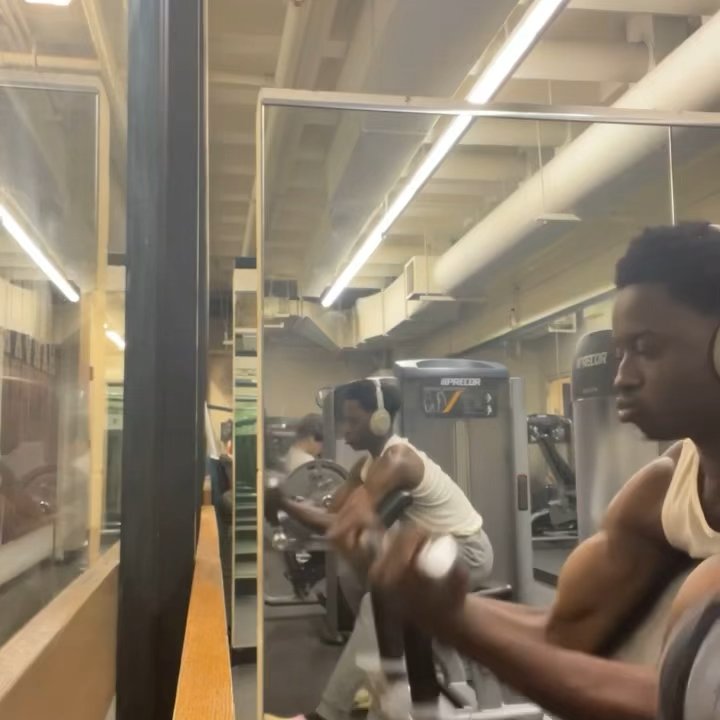
Log in to watch video demonstrations
Login to Watch3 video demonstrations available
Find more video demonstrations in the Gravitus app
Tips from the Community
-

Extend out the arms slowly enough to count to five.
-

Supinate as much as possible and squeeze at the top
Track your progress with Gravitus
Download Gravitus to log your workouts, track your progress, and join a community of fitness enthusiasts.

Helpful Resources
One Rep Max Calculator
Find your one rep max for any exercise without maximal testing. Essential for developing effective strength training programs.
Calculate 1RMWorkout Programs
Follow structured workout programs created by fitness professionals to maximize your strength and muscle gains.
View Programs
